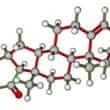Background
- Progesterone is a steroid hormone produced in the ovaries, placenta (during pregnancy), and adrenal glands, and it is involved in the female menstrual cycle, the maintenance of pregnancy, and embryogenesis (the formation and development of a baby).
- Progesterone levels are relatively low before ovulation, rise after ovulation, and are elevated during the luteal phase, which is the phase of the menstrual cycle that starts at ovulation and ends the day before menstruation. Progesterone testing is done to help find causes of infertility, to determine ovulation, to assess the risk of miscarriage, to monitor the function of the ovaries and placenta during pregnancy, and to help diagnose problems of the adrenal glands and some types of cancer.
- Estrogen, another hormone, and progesterone work together in the body. Estrogen and progesterone combinations are commonly used in hormone replacement therapy (HRT) in postmenopausal women.
- Progesterone may benefit women with menorrhagia (abnormally heavy and prolonged menstrual bleeding) and may serve as a treatment for premature birth prevention. Progesterone is also often used as a conception aid.
- Progesterone has been examined for its effects in a variety of conditions, including breast pain, cognitive performance, endometriosis (condition in which uterine tissue grows outside of the uterus), menopausal symptoms, pre-eclampsia, and premenstrual syndrome. However, strong evidence is currently lacking.
References
- Allen, W. M. Physiology of the corpus luteum, V: the preparation and some chemical properties of progestin, a hormone of the corpus luteum which produces progestational proliferation. 1930;
- Berlin FS, Bergey GK Money J. Periodic psychosis of puberty. Medical Aspects of Human Sexuality. 1985;19(1):194.
- Camacho-Arroyo, I., Pasapera, A. M., Perez-Palacios, G., et al. [Progesterone and its metabolites in central nervous system function]. Rev.Invest Clin. 1995;47(4):329-340. View Abstract
- Dzugan SA and Scipione A. Progesterone misconceptions. Life Extension. 2006;12(4):48-55.
- Herzog, A. G. Catamenial epilepsy: definition, prevalence pathophysiology and treatment. Seizure. 2008;17(2):151-159. View Abstract
- Huang, M. C., Wang, Y. B., and Chan, C. H. Estrogen-progesterone combination for treatment-refractory post-partum mania. Psychiatry Clin.Neurosci. 2008;62(1):126. View Abstract
- Kastner, P., Krust, A., Turcotte, B., et al. Two distinct estrogen-regulated promoters generate transcripts encoding the two functionally different human progesterone receptor forms A and B. EMBO J. 1990;9(5):1603-1614. View Abstract
- Khalil, R. A. Sex hormones as potential modulators of vascular function in hypertension. Hypertension 2005;46(2):249-254. View Abstract
- Marshall, J. K. and Hunt, R. H. Hormonal therapy for bleeding gastrointestinal mucosal vascular abnormalities: a promising alternative. Eur.J.Gastroenterol.Hepatol. 1997;9(5):521-525. View Abstract
- Martin A, Barus J Houdret JC. A case of transvestism: a psychological and phenomenological outline. Annales Médico-Psychologiques. 1967;2(3): 427-437.
- Park, D., Huang, T., and Frishman, W. H. Phytoestrogens as cardioprotective agents. Cardiol.Rev. 2005;13(1):13-17. View Abstract
- Schiffman, S. S., Sattely-Miller, E. A., Suggs, M. S., et al. The effect of pleasant odors and hormone status on mood of women at midlife. Brain Res.Bull. 1995;36(1):19-29. View Abstract
- Spetz, A. C., Zetterlund, E. L., Varenhorst, E., et al. Incidence and management of hot flashes in prostate cancer. J.Support.Oncol. 2003;1(4):263-70, 272. View Abstract
- Teja, J. S. Periodic psychosis of puberty. A longitudinal case study. J.Nerv.Ment.Dis. 1976;162(1):52-57. View Abstract
- Young, J. K. Estrogen and the etiology of anorexia nervosa. Neurosci.Biobehav.Rev. 1991;15(3):327-331. View Abstract







